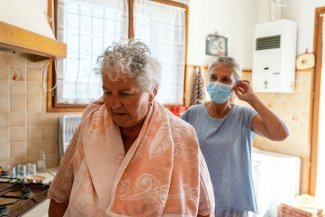Mariuxi Martínez, of Ecuadorian origin, has been caring for the elderly for 12 years.
Once upon a time, not so long ago, being a carer was not a choice people made. It was a condition that was determined at the very beginning of a person’s life: being born a man or being born a woman. And so, for centuries, women did this work, without pay and without discussion. Today, Mariuxi Martínez can affirm that it was her choice or, at least, partly.
“I didn’t like it, at first,” she admits, but there was no alternative. When she arrived in Spain from Ecuador, it was the only job opportunity she could find. She has been caring for the elderly for 12 years now and despite all the hard work and the fatigue, the difficulty of dealing with deterioration and illness on a daily basis, and how overwhelming it is to share the last moments of a person’s life, she admits that, yes, she has grown to like it. “I wouldn’t change it for anything. It makes you realise how necessary it is.”
Official recognition of the status of care workers is quite recent in Spain. It was only formalised in 2006, alongside the passing of legislation on dependency care, which introduced the right of all people to receive care until the end of their lives.
Although Spain has always been a country with a strong tradition of family care, over 600,000 people have joined the professional care sector in recent years, of whom approximately 274,000 care for the elderly in their own homes and 346,000 in residential care homes.
It is an occupation that was born to be never-ending (the 9.3 million over-65s in Spain today will grow to 15 million in 2050) but its future is strangely uncertain.
The reason for this is that the salaries it pays are at the bottom of the wage tables, the rate of temporary and part-time work is higher than the average for any other profession, and the physical and psychological hazards of the occupation, although numerous, are not recognised. It is a professional yet invisible and imbalanced occupation in which women still represent almost 90 per cent of the workforce. The fact that they still choose to care today is nothing short of a miracle.
A cheap and precarious sector
The care sector in Spain was born weak – it has never been equipped with sufficient funding, just 0.7 per cent of GDP – and uncoordinated, with the 17 autonomous communities each managing it in their own way. This meant that, for many years, care remained in the hands of families and informal carers.
Over time, the sector has been professionalised, but has one peculiarity: although a public service – like health and education – it is largely managed by private companies. “In the health care sector, almost 80 per cent of its management is public and 20 per cent private. In dependency care it is the other way round, 77 per cent is privately managed and 23 per cent public,” explains Silvia Espinosa, from the FSS, a CCOO-affiliated federation representing social and health services workers.
Companies compete for public sector contracts that are periodically renewed in tenders where the cheapest bid wins. This, according to Espinosa, is “the root of the shortfalls” suffered by these workers, starting with the pay deficit.
Today, care is not free, and today, care workers receive pay, although it is 40 per cent below the average income. The minimum basic salary established by the collective agreement for home care workers is €984 a month, €7.85 an hour. “The work has been professionalised, but not dignified,” laments Carmen Diego, spokesperson for the home care workers’ platform, Plataforma Unitaria de Auxiliares del SAD. “The pay is very low and the conditions are far from ideal. That’s why young people don’t want to do it, and there’s no generational change.”
In addition to being poorly paid, their work is also more precarious. According to the report Esenciales y sin derechos (Essential and Without Rights) published by Oxfam in 2021, 32 per cent of employment contracts in the sector are temporary – as compared with the Spanish average of 22 per cent – and 24 per cent are part-time, with very few hours – as compared with 14.6 per cent in general. Other studies put the proportion of part-time workers at 60 per cent. Either way, you only have to ask any at-home care worker to see that dismal working hours, often divided into split shifts, are the most common.
“The average is 20 to 25 hours a week,” says Martínez. “We are lucky if we have a little more than 30.”
“The high level of part-time work means present and future poverty,” says Espinosa. “It is a tool for squeezing women workers.”
Hazardous work
Those employed in residential care homes also know about low wages and excessive workloads. “Our biggest problem is the non-compliance with the ratios, the staff shortages,” criticises Sonia Jalda, president of Trega, the association of nursing home workers. “As there’s not enough staff, you have to run. They ask us to attend to one person in 10 minutes, as if it were an assembly line.”
The excess workload results in a string of ailments, both physical – back injuries, slipped discs, damage to the neck and arms – and psychological – stress, depression, anxiety. Care work is among the professions with the highest rate of absenteeism due to medical leave. “Think that our clients weigh at least 75 kilos. Lift them, put them in a wheelchair, lift them out and sit them on the sofa. That’s already 300 kilos in half an hour. Not even a docker does that,” says Diego.
And yet none of these occupational hazards are listed. There are no prevention plans and when damage occurs, it is rarely recognised as a work-related accident or an occupational disease. This is how carers end up accumulating pain, dampening it with painkillers and antidepressants. Sick bodies taking care of even sicker bodies. “Once, at a client’s house, my back seized up. They told me I had a displaced intervertebral disc,” says María Jesús Saura, who has been working as a carer for 14 years. “I’ve had surgery on my spine, I have a plate and six screws, I can’t lift more than 15 kilos and I’m still working.”
Defending publicly run care
In 2021, hundreds of women dressed in white coats took to the streets of Spain. After having experienced the drama of the pandemic first-hand (especially in nursing homes where, in 2020 alone, 16,000 elderly people died from Covid), after working their fingers to the bone and putting their own health at risk – they were the second most infected group after healthcare workers – carers began calling for the same rights that other workers have always taken for granted: decent pay, occupational health and job stability.
“We have a very big responsibility,” says Aurora Alonso, a carer and UGT representative. “We have to know how to move a person, what medication they have to take, what food they need and we are well trained for that. The problem is that we are not recognised as professionals, we are often referred to as ‘the girl’, ‘the cleaner’,” she complains. “I think there are more men working in this sector now,” adds Mario Moreno, a carer. “But there are still very few of us. Most men don’t want to do it. It has to be a vocation.”
Faced with the rising demand for care and a workforce that is increasingly hard to find, the Spanish government brought together companies and trade unions, in 2021, to launch a Shock Plan that promised to address the historic lack of funding, injecting the care dependency sector with €3.6 billion until 2023.
The plan had all-party support, but so far, the unions regret, it has fallen well short of expectations. The budget has increased, but the quality of employment has not.
Both the CCOO and UGT criticise the fact that their proposals have not been taken into account, that there is no plan to limit part-time contracts, the cornerstone of precariousness, or that the brief improvements announced – such as the increase in the ratio of workers in care homes, included in the new Agreement on Accreditation of centres – are insufficient. “The agreement does not guarantee any improvement in the quality of employment. We run the risk that the money will be injected into the system and end up in the pockets of those who manage it,” say the CCOO.
For this reason, workers and trade unions have been arguing for some time that the management of care dependency – like health and education – should be public. This is what they are calling for in their protests. They argue that as public employees, their working conditions would improve. According to a study by the University of Valencia, there is a substantial pay gap between public and subcontracted carers: pay in the public care sector is up to 15 per cent higher – and so too is the quality of the care provided.
“Care cannot be a business, it is a right,” argues Diego. And this implies that the system needs a complete rethink, not just a short-term plan. “If we continue putting the price of the service before the value of care,” she warns, “we will end up with very poor-quality care.”













